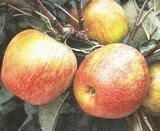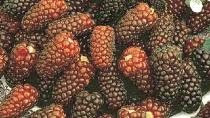I look at buying fruit trees as: obtaining the genetic potential, in a 'package' that is healthy enough for me to grow. I hope they are large enough to produce in a few years, assuming that they respond well to my growth conditions. Most are grafted, again combining the genetic potential of the rootstock, with that of the scion. I also hope they are disease-free and healthy, without injuries. These trees are uninjured, and they were well packed.

Raintree nurseries describes Honeycrisp as: "outstanding crisp texture...sweet and tart flavors...pick it in September, but it develops its full aromatic flavor if left on the tree until mid October...somewhat scab resistant and has not shown problems with fireblight." (Photo from Raintree)

Karmijn de Sonneville is described by Raintree as: intensely flavored red russetted apple from Holland...highest in both sugars and acids...triploid cross of Cox's Orange Pippin and Jonathan...so highly flavored and aromatic that it overwhelms some tastes when just off the tree. (Photo from Raintree)
 Raintree describes Illinois Everbearing Mulberry as "sometimes starts producing the first year...bears an abundance of sweet, highly flavored fruit, 1-1/2 inches long x 1/2 inch wide...berries ripen continuously throughout July, August, and September, hence its name....self-fertile (photo from Raintree). CFRG discusses mulberries, stating "M. alba X M. rubra...1958. Black, nearly seedless fruit large...very long, averaging 12 per ounce. Flavor good to very good, very sweet, considered best by by many. Matures over a long season. Tree vigorous and somewhat dwarfed, extremely hardy and productive."
Raintree describes Illinois Everbearing Mulberry as "sometimes starts producing the first year...bears an abundance of sweet, highly flavored fruit, 1-1/2 inches long x 1/2 inch wide...berries ripen continuously throughout July, August, and September, hence its name....self-fertile (photo from Raintree). CFRG discusses mulberries, stating "M. alba X M. rubra...1958. Black, nearly seedless fruit large...very long, averaging 12 per ounce. Flavor good to very good, very sweet, considered best by by many. Matures over a long season. Tree vigorous and somewhat dwarfed, extremely hardy and productive." This is the same variety, picture from Starks Brothers Nursery.
This is the same variety, picture from Starks Brothers Nursery.Plant expert Arthur Jacobson states: "few fruit trees in fact are so easily neglected without crop loss...mulberries fall when ripe, and with a splat notify the world that if they be not eaten fresh, forget it. Marketing mulberries is therefore difficult... Many people... cannot bide the thought of stains --mulberry juice is dark and persistent to an infamous degree...plant your 'Illinois Everbearing' tree well away from paving, patios or walks. Then, beginning the very first year, you can enjoy its fruit all summer"
I have not seen mulberries grown by this method, but I don't see any reason not to try. It will be easy to cover with netting to keep the birds off - and birds are a reason that some people quit growing this fruit.
I will try to grow the pruned portion as well, as a cutting. If it grows, it may make a nice gift. CFRG states: "No special pruning techniques are needed after the branches have been trained to a sturdy framework...can be kept to a tidy form by developing a set of main branches, and then pruning laterals to 6 leaves in July in order to develop spurs near the main branches..not advisable to prune the trees heavily since the plant is inclined to bleed at the cuts. Cuts of more than two inches in diameter generally do not heal and should be avoided at all cost. The bleeding will be less severe if the tree is pruned while it is dormant." Mulberries are related to figs, and I suspect that similar issues apply.
No comments:
Post a Comment